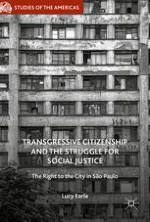2017 | OriginalPaper | Chapter
3. São Paulo: The Illegal City
Author : Lucy Earle
Published in: Transgressive Citizenship and the Struggle for Social Justice
Publisher: Springer International Publishing
Activate our intelligent search to find suitable subject content or patents.
Select sections of text to find matching patents with Artificial Intelligence. powered by
Select sections of text to find additional relevant content using AI-assisted search. powered by
